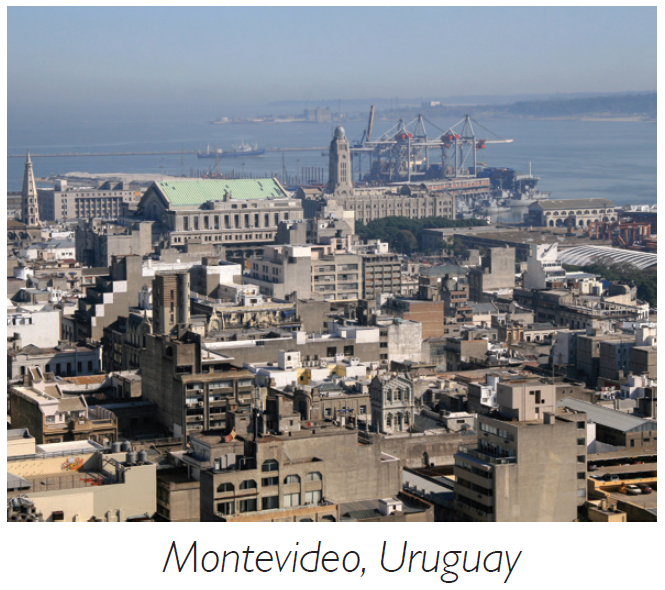Borrower Overview
TriLinc has provided financing to a Uruguayan family-owned citrus producer, founded in 1973, that specializes in growing, processing, packaging, and exporting citrus fruits, juice concentrate, and essential oils. The borrower cultivates 4,700 hectares of proprietary land, supported by over 700 seasonal workers, in addition to purchasing product from 23 local farms/producers. The company is certified under the guidelines of Tesco Nurture and Unilever’s Sustainable Agriculture Code, demonstrating its commitment to operating in an environmentally responsible manner. The company employs one of the most technologically advanced systems in Latin America- sorting fruit by weight, size, and color- thus ensuring compliance with strict international quality controls. The company’s main off-takers are large European, US, and Asian companies including Walmart, Tesco, and Carrefour. Additionally, it is the only company in Uruguay with a license to export citrus product to the United States and China. TriLinc’s financing will support the company’s efforts in increasing agricultural production to meet the demand stemming from new international markets, thereby facilitating export diversification in Uruguay.
Market Overview

Uruguay is classified as a high income country by the World Bank.1Between 2010 and 2016, GDP growth rates averaged approximately 3.7%.1Uruguay’s main exports are concentrated in beef, soybeans, cellulose, rice, wheat, wood, dairy products, and wool.2 Overall, Uruguay is the 72nd largest export economy in the world.3 Conversely, the country’s main imports are focused in refined oil, crude oil, passenger and other transportation vehicles, vehicle parts, and cellular phones.2
Uruguay meets TriLinc’s standards for its performance across relevant growth, stability, and access metrics.4 In 2017, it ranked 10th across the Latin America and Caribbean region on the World Bank’s Ease of Doing Business index.5 Tax rates and inefficient government bureaucracy are seen as the most pressing hurdles currently facing the country’s productivity and competitiveness.6 As the 12th largest economy in Latin America and the Caribbean7 with a GDP of $52.4 billion, the country’s well developed institutions and technological readiness led Uruguay to benefit from the estimated $268.1 billion in foreign direct investment that flowed into the region in 2016.8 Although the region experienced a 2016 GDP growth rate of -1.4%, the 2019 GDP growth rate is projected to increase to 2.5%.9
Additional Sustainability & Impact Highlights
- The borrower implemented an improved lighting system to increase overall efficiency, make use of natural light, and only illuminate the areas which are in use. Additionally, the borrower reuses and recycles products and residues from processing, such as wood, paper, and citrus waste. Through an innovative washing system, the company has been able to reduce its water usage during processing by 45%.
- Employees who have worked at the company for a minimum of six months are offered health and disability insurance, covering 50-60% of salary in the case of illness, disability, or workplace injury. All employees receive up to a 90-day maternity leave and a 10-day paternity leave.
- The company launched a nutritional education program at 11 local public schools to teach the children enrolled about the benefits and risks of different food groups.
 |
1The World Bank, World Development Indicators Database, Uruguay, 2016. 2CIA World Factbook, Uruguay, 2017. 3The Observatory of Economic Complexity, Uruguay, 2017. 4There is no assurance that our investment in this company or this market will be successful. 5The World Bank, Doing Business, Latin America & Caribbean, 2017. 6World Economic Forum, Global Competitiveness, 2017. 7The World Bank, World Development Indicators Database, 2016. 8The World Bank, Data, Latin America & Caribbean, 2016. 9The World Bank, Global Economic Prospects, June 2017.
The above information is as of the initial date of investment: February 8, 2017.
This borrower is no longer a TriLinc fund investment.
TriLinc originally performed an SDG mapping exercise in December 2017 to map all of our borrower companies, both current and exited from our portfolios, to specific SDGs based off of business activity. TriLinc’s official SDG alignment methodology was not finalized until June 30, 2018. For borrowers that had exited TriLinc’s portfolios prior to this time period, the selected SDGs for these borrower are a reflection of what TriLinc believes would have been the SDG alignment if 1) the SDGs had been in effect and 2) TriLinc had integrated the SDG alignment while the company was in the portfolio. The SDG mapping presented does not include input from Investment Partners or borrower companies given that the companies were no longer in the portfolio when the alignment was finalized.
An investment with TriLinc carries significant fees and charges that will have an impact on investment returns. Information regarding the terms of the investment is available by contacting TriLinc. This is a speculative security and, as such, involves a high degree of risk. Investments are not bank guaranteed, not FDIC insured and may lose value or total value. Some investments may have been made in an investment vehicle that is no longer open for investment. The highlighted investment may or may not have been profitable. There is no guarantee that future investments will be similar.
Want to learn more? Contact Us.
